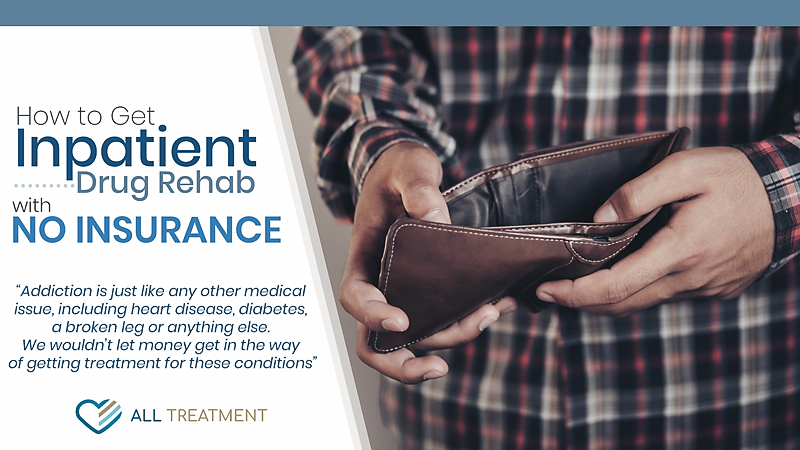How to Get Inpatient Drug Rehab With No Insurance

While it can be difficult for those with limited or no insurance to secure inpatient alcohol and drug rehab, there are a few distinct means of getting the help one needs.
The cruel and ironic reality of serious substance use disorder, a condition that affects over 20 million American adults according to data from the Substance Abuse and Mental Health Services Administration (SAMHSA), is that it not only severely impacts their physical and cognitive health; it often cripples their financial stability by causing them to lose their jobs, and with it, the health insurance they need to pay for life-saving treatment like detox and rehab.
At the same time, many Americans with severe substance use disorder (SUD) will only benefit from the type of inpatient rehab generally paid for by private insurance companies.
From the Kaiser Family Foundation indicates that as of 2016, more than 27 million Americans were uninsured in the United States. For the significant segment of this population that overlaps with the estimated 20 million who need help for SUD, gaining access to quality care can be a nightmare.
As the need for quality treatment becomes more and more apparent, and the United States continues to see record drug overdose fatalities – of which there were over 70,000 in 2017, according to data from the Centers for Disease Control and Prevention (CDC) – the disparity between need and access to care is becoming increasingly unsustainable, causing many stakeholders in the addiction treatment landscape to take further action.
To that end, there are more and more ways to get into inpatient treatment with no insurance. If you need help, consider availing yourself of the following options for access:
Financing for Inpatient Addiction Treatment
We finance our homes, we finance our cars and we finance our education; why not finance a vital and critical life-saving procedure, without which we’re likely to have our lives destroyed? Many inpatient alcohol and drug rehab facilities offer financing or “stay-now-pay-later” options. This allows patients to immediately get the critical help they need for their prolonged and untreated drug or alcohol use disorder while giving them and their loved ones time to get the finances together to start making payments on treatment.
With the average cost of inpatient treatment being about $15,000, and many higher-end facilities reaching $60,000 or higher, each financing agreement will be different according to patients’ and their loved ones’ income and other factors. Most financing programs allow patients a grace period of about six months to start making their payments, giving them and their loved ones time to start rebuilding their lives. The idea is that they can use this time to find a job and rebuild their savings so that when the payments kick in, they have a foundation on which they can continue to pay the treatment center while still meeting their other financial obligations.
You and your loved one can find out if your prospective program offers to finance by speaking to admission or intake professional prior to your entry.
Inpatient Rehab Scholarships and Grants
In special circumstances, some inpatient rehab centers may provide gifts or scholarships to those without insurance. These situations are often need-based or have some other unique situation attached to them, and may only cover part of the cost of treatment. The Substance Abuse and Mental Health Services Administration (SAMHSA) also offers scholarships. These funds usually come from a foundation or nonprofit organization or another philanthropic entity. This kind of money comes through fundraising events and donations.
Scholarships for inpatient alcohol and drug rehab are commonly reserved for more at-risk populations, including women, pregnant women, children, low-income families, families from ethnic minority backgrounds, etc. Eligibility criteria for these scholarships vary greatly; however, they are generally reserved for those who have demonstrated a clear and discernable willingness to get help and fully commit to their treatment program.
It’s important to do thorough research when applying for these scholarships. Information is available from the SAMHSA website and can also be obtained from the facility in which you’re interested.
Sliding Scale Inpatient Addiction Rehab
Some inpatient alcohol and drug rehab facilities offer what is called a “sliding scale” service that allows you to pay what you can for treatment. This is a fee structure in which, after an initial assessment, the patient and the facility will come up with a number that the patient or their loved ones can reasonably handle and agree on a cost of treatment. Evaluations for sliding scale addiction rehab include the examination of a number of criteria, including the patient’s expenses, household size, and income, as well as any outstanding debts or loans that have to be repaid. Patients with considerable outstanding debt will have the option of paying than those with lighter financial obligations. Evaluations are typically done by the facility’s financial controller.
Crowdfunding and Other Options for Inpatient Rehab Without Insurance
Individuals who are members of certain churches or other community groups may have the benefit of virtual or live fundraising. Organizations like the Salvation Army and local religious congregations routinely rally to help their members get the treatment they need.
Personal loans from family or loved ones is another common, though for many, less preferable means of getting help. Finally, if prospective patients are lucky enough to have this kind of cash on hand, they can pay out of pocket.
While it may seem like a lofty and expensive proposition to pay for an inpatient treatment facility, the reality is that it’s the most important investment you can make if you fall victim to substance abuse. Addiction is just like any other medical issue, including heart disease, diabetes, a broken leg or anything else. We wouldn’t let money get in the way of getting treatment for these conditions; don’t let it stop you from healing from destructive drug addiction.
Resources:

